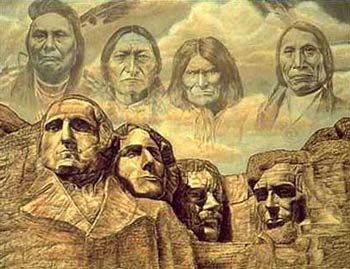Hanging Off Jefferson's Nose
I gather the book is an interesting story of the work involved, but that it is also a 'hurray' for America that doesn't provide a thoughtful look at the complete story of the place or people. Though he is commonly heralded as a great patriot that Coury would like us to emulate, he was a member of the Ku Klux Klan, working on a monument to the Confederacy. (Update, 10:20 AM, June 12, 2012: Elizabeth Burns at School Library Journal asked for a link about Borglum and the Klan. It is mentioned in several books, and at the PBS American Experience webpage about him.)
Hanging from Jefferson's Nose is by Tina Nichols Coury. Here's an excerpt from her website:
That land was taken without the consent of the Lakota people. The U.S. government has tried to settle with them by offering them money, but, that land is sacred to the Lakota's, and they were not, and are not interested in the money. They want the land.
The Lakota's do appear in Coury's book, but not in the way I just described. Here's the page they're on:

(Excerpted from Debbie Reese's American Indians in Children's Literature, 6/2/12.)
Rob's analysis
Here's the text for the page:
What were the political and economic pressures on the Lakota to give up their land? How did they respond to these pressures? Overall, what were their feelings about the Mt. Rushmore project. The book apparently doesn't answer these obvious questions.
Here's what the Wikipedia entry for Mt. Rushmore says about the same period:
As Six Grandfathers, the mountain was part of the route that Lakota leader Black Elk took in a spiritual journey that culminated at Harney Peak. Following a series of military campaigns from 1876 to 1877, the United States asserted control over the area, a claim that is still disputed on the basis of the 1868 Treaty of Fort Laramie (see section "Controversy" below).
As Reese observes, the all-night dance around a campfire is straight out of an old Western movie. She's never seen or heard of a genuine dance like this and neither have I. It looks like pure stereotyping: Indians as savages who express themselves with primitive actions rather than sophisticated words.
In short, Hanging from Jefferson's Nose is another in a long series of failed children's books. For more on Indians in children's literature, see Indian in Worse than Rotten, Ralph and Playing Indian in Not Me!


No comments:
Post a Comment